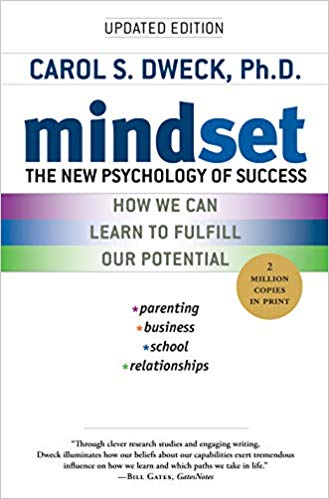

This article is an excerpt from the Shortform summary of "Mindset" by Carol Dweck. Shortform has the world's best summaries of books you should be reading.
Like this article? Sign up for a free trial here .
What’s a growth mindset? What are the best growth mindset strategies? How can they benefit you in school, sports, parenting, and life in general?
We’ll cover six scenarios in which your mindset comes into play and look at how the reactions of people with fixed and growth mindsets differ. Then we’ll look at the best growth mindset strategies to help you learn to get the best out of every situation.
What Is a Growth Mindset?
Before we dive in to growth mindset strategies, we need to know what a growth mindset is and what a fixed mindset is:
Fixed mindset: When you have a fixed mindset, you believe your abilities are unchangeable. You were born with certain traits and a certain amount of intelligence and that’s that. Many people are trained in this mindset from an early age — for instance, by a teacher who believes your IQ determines everything: You’re either smart or you’re dumb; you can learn or you can’t. When you view your abilities as unchangeable, you feel you must constantly prove yourself. If people get a set amount of intelligence, you want to prove you have a lot, although you secretly worry you were shortchanged.
Growth mindset: When you have a growth mindset, you believe the abilities you’re born with are a starting point. You can get smarter and grow with hard work, persistence, and the right learning strategies. You have a passion for learning, welcome mistakes as opportunities to learn, and seek challenges so you can stretch.
The two different mindsets lead to different sets of thoughts and actions, and two different paths. They dictate people’s aspirations; how they see success, failure, and effort; and what that means in school, sports, work, and relationships. Growth mindset strategies can help you develop a mindset that will help you succeed in all these areas.
6 Scenarios and Growth Mindset Strategies
Changing your thinking patterns takes practice. To help you learn new approaches to problems, here’s a series of scenarios in which potential fixed-mindset responses are compared with growth-oriented responses. These will lead to a discussion of the most effective growth mindset strategies.
Scenario 1: Graduate School Rejection
Imagine you applied to just one graduate school — the one you preferred above all others — and you were confident you’d be accepted. But you were rejected. In a fixed mindset, you start by rationalizing: The process was extremely competitive; they probably had more top applicants than they could accept. This evolves into: I’m mediocre; I’m not worthy of being accepted.
Growth Mindset Strategy: In a growth mindset, focus on your goal of graduate school study and how you can remain on track. What concrete steps can you take, such as researching and applying to other schools? What can you learn from the rejection about improving your application? In the real-life version of this scenario, the applicant called the school that rejected her to get information on how to improve. The admissions officer was impressed and decided to accept her application after all.
Tip: People often come up with plans in response to a problem but don’t follow through. You vow to do it tomorrow, but that rarely happens. To succeed, you need to make a concrete, growth-oriented plan with specific implementation steps for when you’ll do what — for instance, tomorrow during my break, I’ll get coffee, close my office door, and call X, following this script. Visualize yourself going through the steps. Then take action, regardless of how you feel.
Scenario 2: Number One Draft Pick
Imagine you’re a promising quarterback and are the top draft pick of the Philadelphia Eagles. While this is what you’ve dreamed of, you’re seized with performance anxiety. What if you can’t live up to everyone’s expectations — yours, the team’s, the media’s, your friends’ and colleagues’? You’re so anxious that you lose focus and perform poorly. In a fixed mindset, you feel like a failure. You keep to yourself, avoiding teammates and the media. You disappear after each game.
Growth Mindset Strategy: Remind yourself that playing in the pros is a totally new experience requiring a big adjustment. You have a lot to learn, which you couldn’t be expected to know at the outset. Ask yourself how you can find out what you need to know. You spend time with veteran players, asking questions and reviewing tapes. You talk about your adjustment process and they empathize and give you advice for adjusting mentally and physically. You begin feeling like you’re part of an organization committed to your development. These are all important elements in your growth mindset strategies.
Scenario 3: The Entry-Level Job
Imagine starting start a new job at the bottom rung of the ladder. You feel the work is demeaning but your boss thinks you have a bad attitude and passes over you for promotion or additional responsibility. Your fixed-minded reaction is that she’s threatened by you. Your talents are obvious and should be rewarded, and you’re entitled to what you want. It’s the organization that needs to change, not you.
Growth Mindset Strategy: Instead of fixating on your superiority, you look for cues on how the company works and how others get ahead. You realize that many CEOs had to start at the bottom too. You notice that effort counts, so you begin working harder. But just working hard doesn’t guarantee success, so you also focus on learning, building relationships, and helping colleagues grow.
———End of Preview———

Like what you just read? Read the rest of the world's best summary of "Mindset" at Shortform . Learn the book's critical concepts in 20 minutes or less .
Here's what you'll find in our full Mindset summary :
- The difference between a growth and a fixed mindset
- How a fixed mindset keeps you back throughout your life: education, relationships, and career
- The 7 key ways to build a growth mindset for yourself






